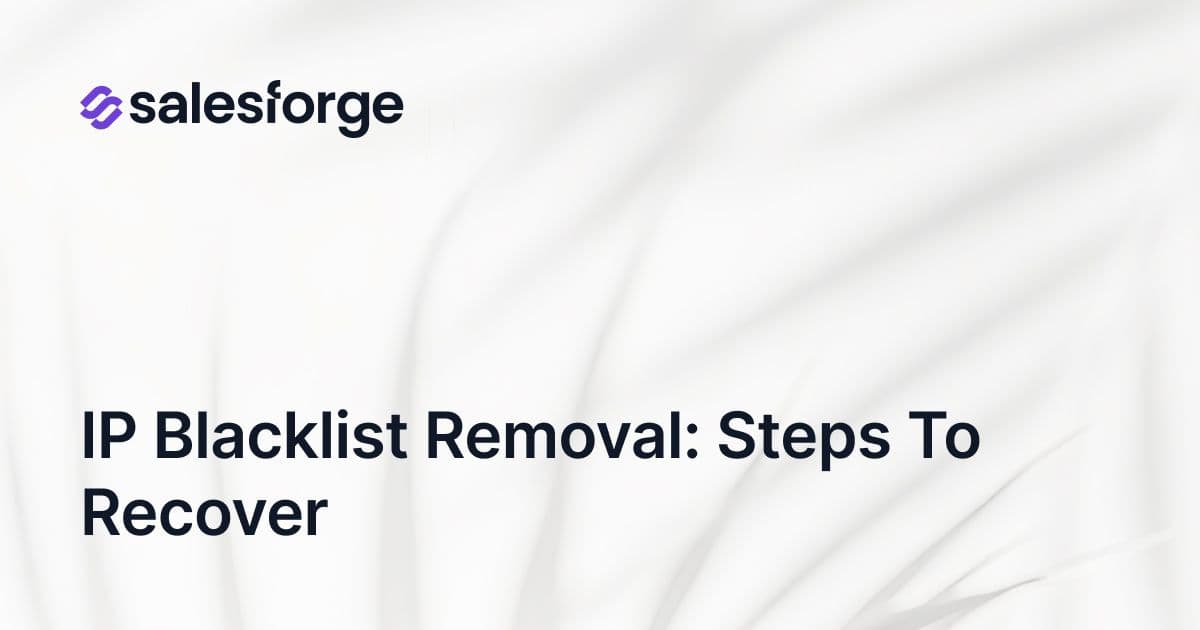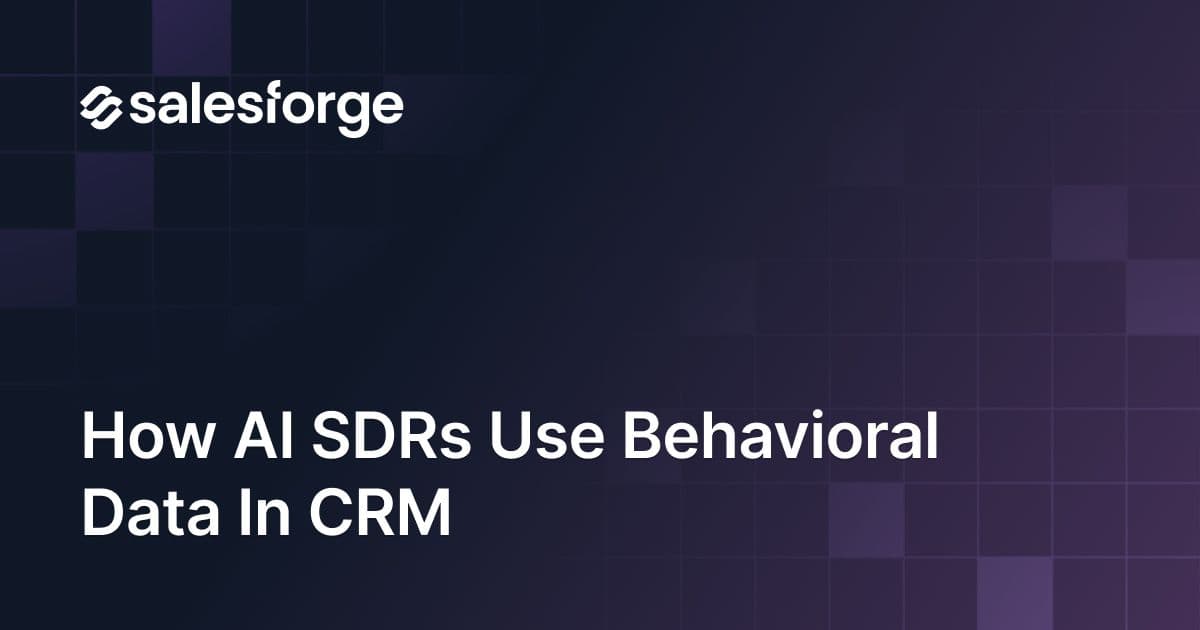How Disposable Emails Hurt Deliverability
Disposable emails can silently sabotage your email campaigns. They lead to higher bounce rates, low engagement, and spam complaints - all of which damage your sender reputation and reduce your emails' chances of reaching legitimate prospects. Here's why they’re an issue and how to address them:
- What are disposable emails? Temporary email accounts used to avoid spam or protect privacy. They’re often abandoned or deactivated quickly.
- Why are they harmful? They inflate bounce rates, drag down open and click-through rates, and increase spam complaints, signaling poor list quality to email providers.
- How to block them: Use tools like email verification APIs, domain blacklists, and double opt-in processes. Services like Salesforge can help automate these steps while improving overall deliverability.
Key takeaway: Cleaning your email list and blocking disposable addresses is critical to protecting your sender reputation and ensuring your campaigns reach real prospects.
How Disposable Emails Damage Deliverability
Disposable email addresses can wreak havoc on your email campaigns, throwing off key metrics and damaging your sender reputation. These temporary accounts often lead to a variety of issues that undermine email performance and long-term deliverability.
Impact on Key Deliverability Metrics
Disposable emails can distort the metrics email providers rely on to assess your campaigns. They often lead to higher bounce rates, lower open rates, and declining click-through rates, all of which make it harder to track performance and refine your strategy.
- Bounce Rates: When disposable emails expire, your messages hit inactive addresses, increasing bounce rates. This signals to providers like Gmail and Outlook that your email list might not be well-maintained.
- Open Rates: These are typically lower with disposable addresses, as users abandon them once they’ve served their purpose.
- Click-Through Rates: Recipients using disposable emails rarely engage deeply with your content, further dragging down this crucial metric.
When these metrics falter, your sender reputation takes a hit, which can have long-term consequences for your email campaigns.
Sender Reputation Damage
Think of your sender reputation as the credit score of the email world. It determines whether your emails land in an inbox or get flagged as spam. Disposable emails can erode this score rapidly.
Providers monitor factors like authentication, engagement, and complaint rates. When disposable addresses bounce, it signals poor list maintenance. Add low engagement and potential spam complaints to the mix, and your reputation can plummet. Over time, this could lead to your emails being routed to spam folders - or worse, getting blocklisted altogether.
Recovering from blocklisting is no small feat. It’s a time-consuming process that can cripple your email efforts, making it crucial to avoid these pitfalls in the first place.
Personal vs. Disposable Emails: A Comparison
Here’s a side-by-side look at how personal and disposable email addresses stack up:
| Factor | Personal Email Addresses | Disposable Email Addresses |
|---|---|---|
| Trustworthiness | High - users provide genuine contact info | Low - designed for temporary use |
| Engagement Rate | Consistently strong | Minimal, often short-lived |
| Bounce Rate | Low with clean, verified data | High as addresses quickly become inactive |
| Spam Complaints | Rare - users expect communication | Higher - users may forget they signed up |
| List Longevity | Supports long-term engagement | Short-lived, often abandoned quickly |
| Conversion Potential | High - reflects genuine interest | Low - rarely tied to purchase intent |
| Deliverability Impact | Positive - boosts sender reputation | Negative - can harm reputation significantly |
This comparison makes it clear: prioritizing verified, personal email addresses is essential for successful email campaigns. Even a small number of disposable addresses can disproportionately harm your performance, making it critical to identify and eliminate them from your list. By focusing on quality over quantity, you can protect your sender reputation and maintain the integrity of your campaigns.
<script>(function(d,u,ac){var s=d.createElement('script');s.type='text/javascript';s.src='https://a.omappapi.com/app/js/api.min.js';s.async=true;s.dataset.user=u;s.dataset.campaign=ac;d.getElementsByTagName('head')[0].appendChild(s);})(document,372145,'tu1or50rqqejh816h1cm');</script>
How to Find and Block Disposable Emails
Blocking disposable emails is essential for maintaining the quality of your email campaigns. By identifying common providers, using detection tools, and enforcing preventive measures, you can minimize the impact of these temporary addresses on your database.
Common Disposable Email Providers
Recognizing disposable email providers is the first step in filtering them out. Services like Mailinator allow users to create temporary inboxes without any registration, making them a popular choice. Similarly, 10MinuteMail generates addresses that expire after 10 minutes, while TempMail offers temporary accounts with slightly longer durations.
Other well-known providers include Guerrilla Mail, ThrowAwayMail, and YOPmail. These services often share telltale signs: predictable domain patterns, instant account creation, and no user verification. Automated tools can easily spot these patterns.
On the other hand, burner email services such as 33Mail and Blur (formerly DoNotTrackMe) create forwarding addresses that users can disable at will. While not disposable in the traditional sense, they allow users to cut off communication instantly, posing similar challenges for marketers.
Understanding these providers helps you configure your detection tools more effectively.
Tools and Methods for Detection
To tackle disposable emails, you’ll need a combination of tools and strategies. Here’s how:
- Email verification APIs: Services like ZeroBounce, Hunter.io, and NeverBounce are reliable options. These tools maintain up-to-date databases of disposable email domains and flag them in real time during the verification process.
- Domain-based filtering: Create blacklists of known disposable email domains. While effective, this method requires constant updates as new services emerge.
- Engagement pattern analysis: Disposable emails often show zero engagement, unusual bounce rates, or spam complaints. Monitoring these patterns helps identify temporary or abandoned accounts.
- CAPTCHA integration: Adding a CAPTCHA to your sign-up process can discourage users from creating multiple disposable accounts.
- Double opt-in verification: This method requires users to confirm their email addresses through a verification email, weeding out accounts that users abandon immediately after creation.
Combining these methods ensures a more comprehensive defense against disposable emails.
Blocking Disposable Emails During Sign-Up
Once you’ve identified disposable emails, the next step is to block them during the sign-up process. Here are some practical measures:
- Real-time validation: Integrate email validation APIs into your sign-up forms to check addresses against disposable email databases instantly.
- Double opt-in and multi-factor verification: Require users to confirm their email address and, if necessary, verify additional details like a phone number. Disposable email users are unlikely to complete these extra steps.
- Domain reputation scoring: Some temporary email providers use domains that appear legitimate. Scoring these domains based on user behavior and characteristics can help flag suspicious ones.
- Form field validation: Use regular expressions and domain checks to detect common patterns associated with disposable emails.
- Rate limiting and IP tracking: Prevent multiple account creations by monitoring activity from the same IP address.
- Email age verification: Check when a domain was registered. Many disposable email services use newly registered domains, so flagging domains less than 30 days old can help catch emerging providers.
Solutions to Fix Deliverability in Cold Email Campaigns
Once disposable emails are out of the picture, it’s time to focus on strategies that protect your sender reputation and boost email deliverability. By combining time-tested practices with cutting-edge tools, you can ensure your messages land where they’re supposed to.
Best Practices for Better Deliverability
To build a solid foundation for email deliverability, you’ll need to focus on a few essential areas consistently:
- Keep your email list clean: Regularly update your list by removing hard bounces, unresponsive subscribers, and flagged addresses. Doing this monthly can significantly improve your chances of reaching inboxes.
- Use authentication protocols: Implement SPF, DKIM, and DMARC to verify your emails. These protocols help email providers recognize your messages as legitimate, keeping them out of spam folders.
- Ramp up email volume gradually: Sending too many emails too quickly from a new domain or IP can raise red flags. Start small and increase your volume over time to establish trust with email providers.
- Optimize your content: Avoid spammy language, excessive capitalization, and unbalanced text-to-image ratios. Make sure to include a clear unsubscribe link and personalize subject lines to catch the recipient’s attention.
- Monitor engagement metrics: Keep an eye on open rates, click-through rates, and spam complaints. This data can help you tweak your strategy and address issues before they escalate.
For a more streamlined approach, leveraging AI-powered platforms like Salesforge can make these best practices easier to implement.
Using AI-Powered Platforms Like Salesforge

Email deliverability challenges often require more than just basic tools. That’s where platforms like Salesforge come in, offering advanced features designed to tackle modern cold email obstacles.
- Email validation tools: Salesforge screens your contact lists to identify disposable, invalid, or risky addresses. This helps reduce bounces and protects your sender reputation.
- Warmforge for domain reputation: Its unlimited warm-up feature mimics natural email activity, building your domain’s credibility and keeping your messages out of spam folders.
- AI personalization engine: Salesforge uses AI to create unique, tailored content for each recipient, boosting engagement and signaling to email providers that your messages are worth delivering. With multilingual support, it’s ideal for global campaigns.
- Primebox™ unified inbox management: This feature allows you to monitor multiple mailboxes from one interface, making it easier to track deliverability metrics across all your accounts.
- Agent Frank, the AI SDR: Salesforge’s AI-powered sales development representative handles everything from lead generation to meeting scheduling across email and LinkedIn. It ensures consistent messaging and timing, reducing human errors that could harm deliverability.
Salesforge vs. Other Email Platforms
When it comes to deliverability, not all platforms are created equal. Here’s how Salesforge compares to others:
- Mailchimp: Great for newsletters but lacks advanced warm-up features and real-time validation tools required for cold email campaigns.
- Outreach.io and SalesLoft: These platforms offer solid features but often require additional subscriptions for email validation, warm-up services, and advanced personalization - adding cost and complexity.
- Apollo and Lemlist: While they provide basic deliverability tools, their capabilities don’t match Salesforge’s AI-driven personalization or unlimited warm-up features. Their personalization often relies on basic merge tags rather than dynamic, automated content generation.
Salesforge stands out by combining all these features - AI personalization, unlimited warm-up, inbox management, and more - into a single, user-friendly platform starting at $48 per month. Its multilingual capabilities make it especially effective for international outreach, ensuring consistent quality across languages. Plus, every feature is built specifically for cold outreach campaigns, reflecting deep expertise in reaching new prospects effectively.
Conclusion: Maintaining High Email Deliverability
Disposable emails might seem like a small issue, but they can wreak havoc on cold email campaigns. They lead to higher bounce rates, poor engagement, and a damaged sender reputation - ultimately derailing your outreach efforts.
Key Points to Remember
Tackling disposable emails requires a proactive, multi-step strategy. These addresses inflate bounce rates and signal low-quality leads, making it harder to connect with genuine prospects.
Start by implementing email validation at the point of entry. Look for patterns common to disposable domains, such as those from services like 10minutemail.com or guerrillamail.com, and block them before they can harm your campaigns.
Using integrated tools can simplify this process. Platforms like Salesforge offer a comprehensive solution that goes beyond just identifying risky emails. They help with domain warming, cleaning up your email lists, and even personalizing content to drive better engagement. This holistic approach doesn't just address disposable emails - it strengthens your overall deliverability for the long haul.
Authentication protocols like SPF, DKIM, and DMARC are essential, but they’re most effective when paired with a clean email list. A solid foundation starts with scrubbing your contacts and ensuring you’re only reaching legitimate recipients.
Next Steps for Sales Teams
Take immediate action by auditing your email lists. Many sales teams are surprised to find how many temporary email addresses are hiding in their databases, dragging down their campaign performance. Use validation tools to clean your current lists and set a benchmark for improvement.
Make email validation a standard practice at every entry point, whether it’s through sign-up forms, lead captures, webinar registrations, or manual uploads. Catching disposable emails early saves time and protects your sender reputation.
If juggling multiple tools feels overwhelming, consider an all-in-one platform. Salesforge, for instance, combines email & LinkedIn outreach with email validation, domain warming through Warmforge, and AI-driven personalization - all starting at $48 per month. This unified approach ensures all elements work together seamlessly, helping you maintain clean lists and achieve better deliverability.
Finally, monitor your key metrics - bounce rates, engagement levels, and overall deliverability. These indicators will show how your efforts are paying off and guide future adjustments.
Maintaining proper email hygiene is the backbone of successful campaigns. Clean lists lead to stronger deliverability, higher engagement, and more meaningful conversations with qualified leads. Taking these steps now will set you up for long-term success in your outreach efforts.
FAQs
How can I check if my email list contains disposable addresses?
To identify disposable email addresses in your list, tools like EmailListVerify or DeBounce can be incredibly helpful. These tools are designed to detect temporary or throwaway domains by checking for things like MX records and DNS mapping, ensuring the domains are valid.
You can also take a hands-on approach by scanning your list for unusual domain names, such as "mailinator.com", or spotting odd syntax that might indicate a fake address. Keeping your email list clean through regular validation not only boosts your deliverability rates but also makes sure your messages reach genuine, engaged recipients.
What are the risks of using disposable email addresses in my campaigns?
Using disposable email addresses in your email campaigns can cause major issues for your long-term deliverability. These addresses are typically temporary and of poor quality, which can negatively impact your sender reputation. Once your reputation takes a hit, your emails are more likely to end up in spam folders - or worse, get blocked entirely by email providers.
There’s more: disposable emails can throw off your campaign analytics. Because these addresses are often created for one-time use or to avoid tracking, they usually represent users who have little to no genuine interest in your content. This messes with your performance metrics, drains your resources, and limits your ability to connect with your real audience.
What are the best strategies and tools to keep your email list clean and improve deliverability?
To keep your email list in top shape and improve deliverability, make regular list maintenance a priority. This means clearing out invalid, bounced, or unresponsive email addresses. One effective way to build a strong list from the start is by using double opt-in, which confirms that new subscribers are genuinely interested.
You can also rely on email validation tools to spot and remove invalid addresses, helping to lower bounce rates. For a better sender reputation, consider using email warm-up services. These tools simulate positive engagement over time, which can improve how your emails are received. By combining these approaches, you'll set your email campaigns up for better inbox placement and stronger results.




